automotive design
4WD and AWD
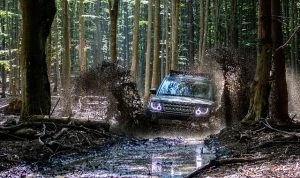
Getting the best grip on the road or terrain is what will get you moving forwards from A to B in the shortest time. Ever since the invention of the first cars, two-wheel-drive has been the mainstay for delivering the engine’s power out to the wheels. At first, two-wheel drive was usually via the rear wheels, as it was much simpler to run a drive shaft from the engine at the front of the car back to the rear wheels to get grip from the rear wheels and to let the front wheels have the job of steering the vehicle.
In saying that, there is also history of 4WD being experimented with back as early as the late 1800s in combination with a traction engine, and, of course, in World War II, the 4WD Willys Jeep was a game-changer.

Once mechanical engineering and quality improved over time, the concept of having the engine over the front axle and the front wheels as the driving wheels as well as for steering the vehicle lowered production costs. A combination of rear-wheel-drive and front-wheel-drive cars were available as a matter of course right up to the 1970s and 1980s. Through the 1990s up until the present day, it was more common to see front-wheel-drive cars for everyday driving.
However, it was the 1980s that proved to be a very innovative period in automotive design and mechanical engineering. The greatest advancement in road-going cars was arguably the use of four-wheel-drive to establish greater levels of grip. As racing and supercars demanded faster cars, the need to control all that power (and actually make better use of it) was essential for winning, especially as there was an ever-increasing number of high-performance cars being pulled out of roadside hedges or being wrapped around power poles.
Enter Audi. Audi’s Quattro technology marked a significant moment in high-performance cars’ and supercars’ history. The Audi Quattro’s technology was essentially the dawn of the modern supercar’s 4WD system, and when Audi entered the World Rally Championship in 1981 with their Audi 80 Quattro car, they were unbeatable. The second-place car was over twenty minutes behind the race-winning Audi!
What is the difference between 4WD and AWD?
This is a good question to answer, because there are numerous new cars of all shapes and sizes available with AWD or 4WD. Generally speaking, four-wheel-drive (4WD) is the older off-road system that has the power split 50:50 front to rear. Add a diff-lock into a 4WD system, and these are off-road kings. Four-wheel-drive can be disengaged so that just two-wheel-drive (2WD) can be used on easier terrain, including for when you’ve finished your off-road adventure and you just want to head back home on the tarmac with 2WD only.
The basic principle of an all-wheel-drive (AWD) system is that it can deliver the optimum level of torque to each wheel individually, thus giving the best possible drive and traction. AWD systems tend to be permanently engaged, but with the power split front to rear, along with individual wheels being variable according to what each wheel is sensing and therefore demanding at the time. AWD systems are more complex in that they use sensors which send precise information and values of each wheels’ speed, torque, wheel slip/spin, brake pressure, and steering input to the AWD’s central control system. The control system then adjusts the torque supplied to each wheel.
Land Rovers and many other new serious off-road vehicles use AWD systems with various diff-locking abilities, which also make them real off-road kings. Four-wheel-drive systems are simpler in nature and are thus simpler and cheaper to fix than more complex AWDs. That said, many manufactures like Subaru know how to make solid, dependable AWD systems for their cars and SUVs that are mainly aimed at everyday on-road use and trips up to the ski fields, but with the credentials for performing well even in some fairly serious off-road terrain.
If you live in a part of the world where gravel roads and rainy seasons collide, then an AWD vehicle with decent ground clearance should be parked up your driveway. If your day includes a trek out to the building site, feeding out to stock, or traversing any serious off-road terrain, then a heavy-duty 4WD or AWD vehicle will be your companion. The good news is there are plenty of these sorts of vehicles about, many of which can be bought new at a good price via Private Fleet.

Talking Tyre Tech

Wheels, alloys, and tyres are pretty mesmerizing things. My mate’s dog thought they were biteable too, especially when moving. He did manage to learn, eventually, that this wasn’t the smartest thing to do, and rather spent his time running alongside the car to welcome visitors instead.
The wheel has been around for a wee while now, having first been thought to have been applied particularly well by the Sumerian people in 4000 BC, in the lower Mesopotamian regions, or what we know as modern-day Iraq. These folk inserted rotating axles into solid discs of wood to move objects from A to B. In 2000 BC, the discs began to be hollowed out to make a lighter wheel. Nowadays we use wheels for all sorts of applications, not least for rolling ourselves from Point A to Point B in cars.
I’m sure that the thought of using something soft for surrounding a wheel’s rim entered the mind of many an inventor or entrepreneur. However, in 1847, it was the Scottish inventor Robert Thomson who patented the first standard pneumatic tire. It wasn’t until 1888 that the first pneumatic tyre, made by John Dunlop (yes, as in Dunlop tyres), was able to be used as a practical application for bicycles. He found that rubber was able to withstand wear and tear and retain its resilience when being used as a bicycle tyre.
The tyre as we know it now has advanced tremendously in its science, physiology, and even application. Generally, a new tyre that we use on our cars today may contain up to 25 components and have as many as 12 different rubber compounds. Rubber still comes from the rubber tree (Ficus elastica), where the basic component (liquid latex) is extracted from the tree and coagulated with acid. It is then cleaned with water and pressed into bales, ready for all sorts of applications, including the tyre.
New developments in tyre technology have been rather underwhelming recently; that is, until Michelin’s latest invention. This exciting development by Michelin has potentially seen the pneumatic tyre being replaced by this new tyre technology. The new Michelin Uptis tyre technology utilizes a non-pneumatic tyre that relies on modern composites. The Michelin Uptis uses aluminium for the wheel, a combination of rubber for the tread, and a flexible load-bearing structure made from reinforced plastic with glass fibre that is used as the tyre’s substance for cushioning road imperfections on impact and coping with variable weight forces, while also maintaining the tyre’s rigidity when accelerating, braking, and cornering.
This ‘substance’ as we know it in a conventional tyre is known as compressed air and the tyre wall, which all work together to maintain grip and the tyre’s structural strength, and to soften road undulations. It is, however, prone to punctures. So, instead of simply air pressure providing the right mix of stiffness, flexibility, and durability, like on our conventional tyres, the new Michelin Uptis prototype tyre uses clever yet simple new technology that will even eliminate the hassle of having a puncture.

Michelin has recently said that this new tyre technology could also help reduce the cost of tyre replacement by up to 20%. Michelin’s Uptis tyre technology has and is being tested, having been fitted to 50 DHL delivery vans in Singapore last year.
Michelin Uptis tyres look pretty cool, too, because you can see right through the outer sidewall of the tyre to the other side and beyond, thanks to all the vacant spaces between the incredibly tough and elastic plastic pillars holding the integrity of the tyre together.
Kei Cars: The Little Cars That Can
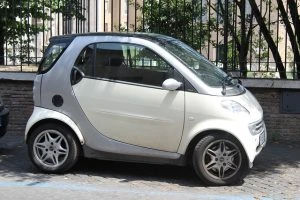
In the Western world, cars seem to have been getting bigger. For example, my early 2000 Volvo S70, a generous sedan when it came out, is shorter than the more modern “little” hatchbacks in the supermarket car park beside it. However, this isn’t the case around the world. In Japan, congestion is a problem in busy cities such as Tokyo and Kyoto, so one of the solutions was to introduce what are known as kei cars, also known as compact cars. Some people call these K-cars, as this is approximately the way the word “kei” is pronounced.
The concept of kei cars isn’t new; in fact, the Japanese government introduced the general idea and legislation related to these vehicles in the late 1940s as part of the post-WWII recovery efforts. Back then, it was more about encouraging car ownership and stimulating the local automotive industry (and you can see for yourself how well that worked, given the number of Japanese makes on Australia’s roads). Today, however, it’s more about congestion and fuel consumption.
What is a kei car? As the Japanese name suggests (in full, it’s kei-jidōsha), it’s a small car. Specifically, it’s one that has restrictions on its size, both in terms of its dimensions and its engine displacement. To qualify as a kei car, an automobile has to be no taller than 2 metres, no wider than 1.45 metres and no longer than 3.4 metres. In terms of engine displacement, the maximum allowed is 660 cc. There’s no official limit on engine power, but it’s very unusual for a factory kei car to have more than 47 kW. Not that tuning and tweaking to get a bit more power is out of the question for those interested… Most of them are speed-limited to 140 km/h, which makes sense, given that these are designed for crowded city streets, not open road rural running. The width means that they don’t handle quite as well at high speeds, so that’s another reason why their top speed isn’t as high as what you’d find with the average Toyota Corolla.
Needless to say, electric kei cars are out there as well.
To encourage the adoption of kei cars, the Japanese government has a few incentives set up. If a car qualifies to have the distinctive yellow kei plates, it’s exempt from the need to buy parking space (apparently, to buy a car in Japan, you first have to buy street space to park it). Various on-road taxes are reduced with kei cars, as these taxes are based on things such as the engine displacement and the weight.
Now, we all know that where there are large numbers of people, there are houses to fix and goods to be transported, which require vans and trucks. Your typical kei car has the sort of cargo space that would suit a minimalist (Marie Kondo would love these, if she doesn’t already). However, kei vans and kei trucks are a thing – although we’d call latter kei utes, as they’re “pickup truck” rather than a miniature version of a big old Scania. The kei vans or microvans are allowed to be taller than the kei cars, which allows the to carry more of a load and has earned them the nickname of “miàn bāo chē” (meaning “bread loaf cars” in nearby China. The kei trucks have the same basic wheelbase but a cab-chassis layout.
Because of their low fuel consumption, suitability for urban settings, kei cars and their relatives are growing in popularity in other parts of the world outside Japan. Their general cuteness relates to another Japanese concept, namely the kawaii (cute) aesthetic. Although many customers in Australia are leery about very small cars, given that physics says that they’re not going to come off well in a collision with an SUV, some popular kei marks are found in the Aussie market. Do any of these sound familiar?
- Suzuki Alto
- Suzuki Jimny
- Misubishi i-Miev
- Smart ForTwo (this one is unusual, as it’s a kei car that’s not from a Japanese marque).
These are all “regular” cars that meet the criteria for kei cars that you can find down at your local dealer (which is why we have them in our reviews page). Plenty of people also arrange for private imports of popular kei cars such as various Daihatsu models, the stylish Honda Beat coupe convertible, the Suzuki Every van, the Toyota Copen sports car and the Subaru Sambar, just to name a few. There’s even a kei version of the Mitsubishi Pajero, the Pajero Mini.
The Nissan Hyper Force Concept Car
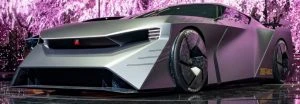
There would be little debate over whether a Nissan GT-R is a legendary supercar or not. It has been one of the most exciting cars of the last two to three decades, having even set a record on the Nürburgring racetrack of 7:08.68 min in 2013, which was achieved by the Nissan GT-R NISMO.
Recently, the Nissan Hyper Force concept car stunned the crowds at a car show in Japan. Could this concept potentially be the next new Nissan GT-R supercar?
The Nissan Hyper Force is an all-electric beast with a seriously brazen design suggesting time warp speeds! In the car’s layout is an application of some clever revolutionary solid-state batteries that enable the supercar’s output to power up to 985 kW. That’s almost 600 kW more than the current GT-R! It’s also good to see that solid-state batteries are starting to break out of the laboratory and into actual vehicles, as they have better safety performance. However, these solid-state batteries are inside something that’s got that little hit of adrenaline. This electric vehicle is electrifying.
With this level of output, the Nissan Hyper Force Concept car is carefully aerodynamically designed to ensure the air is pushed over the car to force it down on the road. In order to achieve the required levels of downforce, there are active winglets up the front end of the car to help channel air over the car, as well as a massive air scoop in the lower bumper, and an array of active fins for air manipulation. If you look at the back of the vehicle, the telltale twin LED taillight clusters are very typical of the Nissan Skyline GT-R. The massive wheel arches on the AWD machine look really spectacular, hiding what must be some serious rubber tyre profiles. If I were making a Batman movie, I’d cast this vehicle as the latest iteration of the Batmobile.
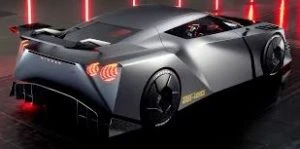
The doors open upwards and forwards in a gullwing-like action. Once the doors are opened, the onlookers are presented with a stunningly wild interior, featuring Lamborghini-crazy styling that is incredibly futuristic, offering sizzling red LED lighting vibes for high-speed driving modes. Gentler GT modes light up the interior in a blue colour. There are plenty of information displays and stylish graphics, as you’d expect. The interior styling continues the edgy, angular diagonal lines of the exterior, giving a Batmobile vibe. And did I see harness style seatbelts in there?
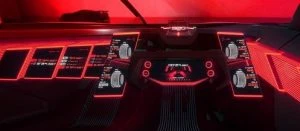
The Nissan Hyper Force concept was at the Japanese car show to inspire people, and to give them a taste of what a new roadgoing Nissan supercar (potentially GT-R) of the future might look like. This is seriously cool! Here’s hoping that we’ll see some of the ideas trickling down. I particularly like the idea of the ambient lighting changing with the driving style, so I hope that we see that one in upcoming Nissan models. I’d also like to see the harness-style seatbelts making their way into regular cars, though they’d take a bit of getting used to, especially for a women (but they could easily be an improvement over the three-pointers we’re used to).
Find out more and have a drool in the official promo video from Nissan: